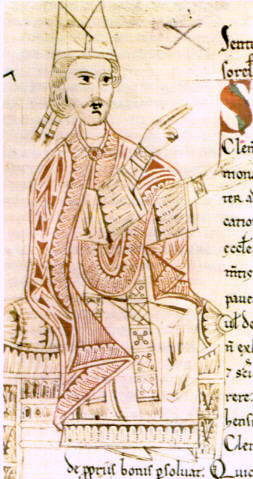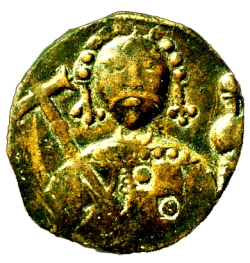 |
| Boniface III of Tuscany |
Family Fortunes
Matilda[i] was born in 1046, the youngest of
the three children of Margrave Boniface III of Tuscany. Boniface was the most powerful
prince in northern Italy; being not only Margrave but also Count of Brescia, Canossa, Ferrara, Florence, Lucca, Mantua, Modena, Pisa, Pistoia, Parma, Reggio, and Verona from 1007.
Boniface had
fought to impose his rule over his varied fiefs; in 1021 he won the battle of
Coviolo to secure his grip on Emilia and supported Conrad II in his fight to become Holy Roman Emperor. As thanks for that backing Conrad
had given Boniface the Margravate of Tuscany. In return Boniface supported
Conrad in later campaigns[ii].
After Conrad’s death in 1039 Boniface fell out with his successor Henry III who held that Canossa was too
powerful.
In 1037,
Boniface married Beatrice, his second wife[iii].
She was the daughter of Frederick II, Duke of Upper Lorraine and Count of Bar, and niece and adoptive daughter of
the Empress Gisela, wife of Conrad II. Beatrice gave
birth to a daughter Beatrice, then a son Frederick, and finally Matilda.
Matilda was
taught French and German[iv]
in addition to Italian and she appears to have had some little proficiency in
Latin. Claims that Matilda underwent weapons training are unverified. She does
appear to have assimilated the skills to strategically and tactically manage
armed forces from her father, stepfather, mother and husband number one.
New Family Dynamics
 |
| Beatrice of Bar |
In 1052 Matilda’s
father was assassinated with a poisoned spear[v].
Many suspected the emperor of organising the assassination which suited Henry’s
aims of reducing the power of the Tuscan Margravate. Boniface’s elder daughter
Beatrice died shortly after him. Frederick succeeded his father. Boniface’s
widow Beatrice, raised at the imperial court and able to play court politics,
acted as regent for first Frederick and later for Matilda.
Beatrice
remarried in 1054 to Godfrey III, who ruled on Matilda’s behalf until his death in 1069. The
feud with Henry III was not assuaged by this marriage; Godfrey was one of
Henry’s bitterest enemies[vi]
and a capable general, able to continue the fight against the emperor. The
marriage strengthened Godfrey’s claim to Lorraine as Beatrice’s father had been Duke of Upper Lorraine.
Matilda’s
brother Frederick died in 1055 in suspicious circumstances and Matilda inherited the Countship from him. In
the same year the emperor marched over the Alps and drove Godfrey from Tuscany and took Matilda and Beatrice captive.
Despite this setback Godfrey refused to capitulate so Henry returned to Germany
with his prisoners in tow.
Godfrey’s
rebellion reduced the power of the emperor over his far-flung lesser barons and
his neighbours, most notably the king of France. Henry made attempts at rapprochement with Godfrey, but died in October 1056.
He was
succeeded by his son Henry IV. In December of that year Godfrey
was formally reconciled with the emperor and recognised as the Margrave of
Tuscany. Godfrey was able to take his family home, accompanied by Pope Victor II[vii]. Matilda was formally recognised as
heir to her father’s lands.
Marriage Number One
 |
| Godfrey the Hunchback |
When Godfrey
lay dying after a long illness at the end of 1069, Matilda and Beatrice made
the journey to Bouillon, where Godfrey had established his
court after the return of his dukedom in 1065. Not long after her stepfather’s
death Matilda married Godfrey’s son Godfrey the Hunchback. The couple had been engaged for a
long time.
Two years
later Matilda bore her only child, Beatrice who died the same year. Around the
same time the marriage dissolved into acrimony and Matilda left Godfrey in
Lorraine to return to her lands in Tuscany. She refused to return;
‘Matilda, leaving him
behind, returned to Lombardy. And when her husband frequently ordered that she
return, not only did she not comply, but she declared to him who gave the order
that he should come to her.’[viii]
In 1071
Matilda indicated her intention to rule her patrimony without the support of
her husband. Beatrice began teaching Matilda the skills needed to rule, jointly
holding courts with her daughter.
Papal Support
 |
| Pope Gregory VII |
After Pope Gregory VII’s coronation in April 1073 Matilda frequented papal councils and synods. She
corresponded with the pope who was more than happy to open the Vatican’s doors
to Matilda and her family;
‘Therefore should it happen
that your illustrious mother returns at this time to Rome, with all our heart
we charge, or rather beseech, your excellency to pay a visit to the apostles in
her company.’[ix]
In 1073
Godfrey travelled to Tuscany in order to enlist the support of his stepmother
and of Pope Gregory VII. Godfrey promised Gregory that he would provide
military support in return for papal assistance in getting his wife back.
Matilda refused to back down and by 1074 Godfrey seems to have given up any
hope that Matilda would return to Lorraine.
After the
failure of his Tuscany trip in 1073 Godfrey had nothing more to do with either
Matilda or Gregory and notably failed to send the promised troops. Instead he
became one of the Holy Roman Emperor’s most trusted allies.
At some time
between 1074 and 1080 Matilda willed all her domains to the church, in open
defiance of Henry IV's claims both as the overlord of some of those domains,
and as her close relative. Gregory’s indulgence towards a woman defying the standards set for a
medieval woman may very well have been because his church reforms were in need of substantial backing[x].
A Papal Crusade
 |
| Coin of Robert Guiscard |
In 1074, having
made enemies all around from the Holy Roman Emperor, impatient with what he saw
as the arrogance of the Catholic church, to Robert Guiscard, the leader of the Normans in Sicily and not forgetting the Seljuk Turks, Gregory determined to free the church from any interference
by the Holy Roman Emperor and from the emperor in Byzantium. Gregory intended that all Christendom should be subject to Rome.
Matilda, with her financial and military support to the church, was allowed a
great degree of leeway.
Gregory
organised a military offensive with Matilda as one of its leaders.
‘Let this messenger of yours
come by way of Countess Beatrice, who with her daughter and son-in-law, has it
in train to contend in this business. But we are not at pains to assemble this
multitude of knights so that we may proceed to shedding the blood of
Christians….when the Normans are brought to peace we may cross to
Constantinople to bring aid to Christians….afflicted by the most frequent
raving of the Saracens.’[xi]
Matilda and
her mother attended the councils of war and prepared to lead their troops into
battle on the pope’s behalf. Matilda attended Gregory’s Lenten synod from 9th to 14th March 1074, along
with Prince Gisulf of Salerno. To avoid the stigma of Christians
fighting Christians Gregory took the precaution of excommunicating Robert
Guiscard.
Gregory was
not amused when Godfrey’s troops failed to materialise, but Matilda and
Beatrice rendezvoused with the pope at San Flaviano. The expedition collapsed after
numerous mishaps and quarrels among the various nobles who had answered the
pope’s call. By 1075 even the pope had given up on the idea of chastising
Robert Guiscard. He returned to his self-imposed challenge of reforming the
church.
Bibliography
The Making
of Europe – Robert Bartlett, Penguin Books 1994
The Military
Leadership of Matilda of Canossa – David J Hay, Manchester University Press
2008
The Holy
Roman Empire – Friedrich Heer, Phoenix Giant Paperback 1995
The Oxford
History of Medieval Europe – George Holmes, Oxford University Press, 2001
Absolute
Monarchs – John Julius Norwich, Random House 2011
The
Hapsburgs – Andrew Wheatcroft, Folio Society 2004
www.wikipedia.en
[i]
Also known as Matilda of Tuscany
[iii]
Boniface was first married to Richilda,
daughter of Giselbert
of Bergamo, who bore him no children. She died between 1034-7
[iv]
Beatrice had lived at Conrad’s court whilst a girl, so she must have spoken
German
[v]
This version of Boniface's death is disputed. Some have alleged that Henry
played a part in his assassination. It is also held by some that in 1044 there
was an attempt made on the Margrave's life at Brescia and that the
conspirators fled to Verona,
which Boniface subsequently sacked before expelling some Veronese conspirators
from Mantua as well. One Scarpetta
Carnevari apparently nursed a grudge for this act and years later, while
Boniface was preparing a galley for a pilgrimage to Jerusalem,
shot him with a poisoned arrow on the river Oglio, near Martino
dall'Argine in the region of Spineta while on the hunt.
[vi]
Godfrey was one of Beatrice’s distant kinsmen, who had been stripped of the Duchy of Upper Lorraine after openly
rebelling against Emperor Henry III
[vii]
The fourth and last pope nominated by Henry III, who was to be a strong
defender of the church against the Holy Roman Emperor. He died in 1057, victim
of the miasmas of the Pontine
Marshes
[viii]
The Military Leadership of Matilda of Canossa - Hay
[ix]
Ibid
[xi]
The Military Leadership of Matilda of Canossa - Hay
No comments:
Post a Comment
Note: only a member of this blog may post a comment.